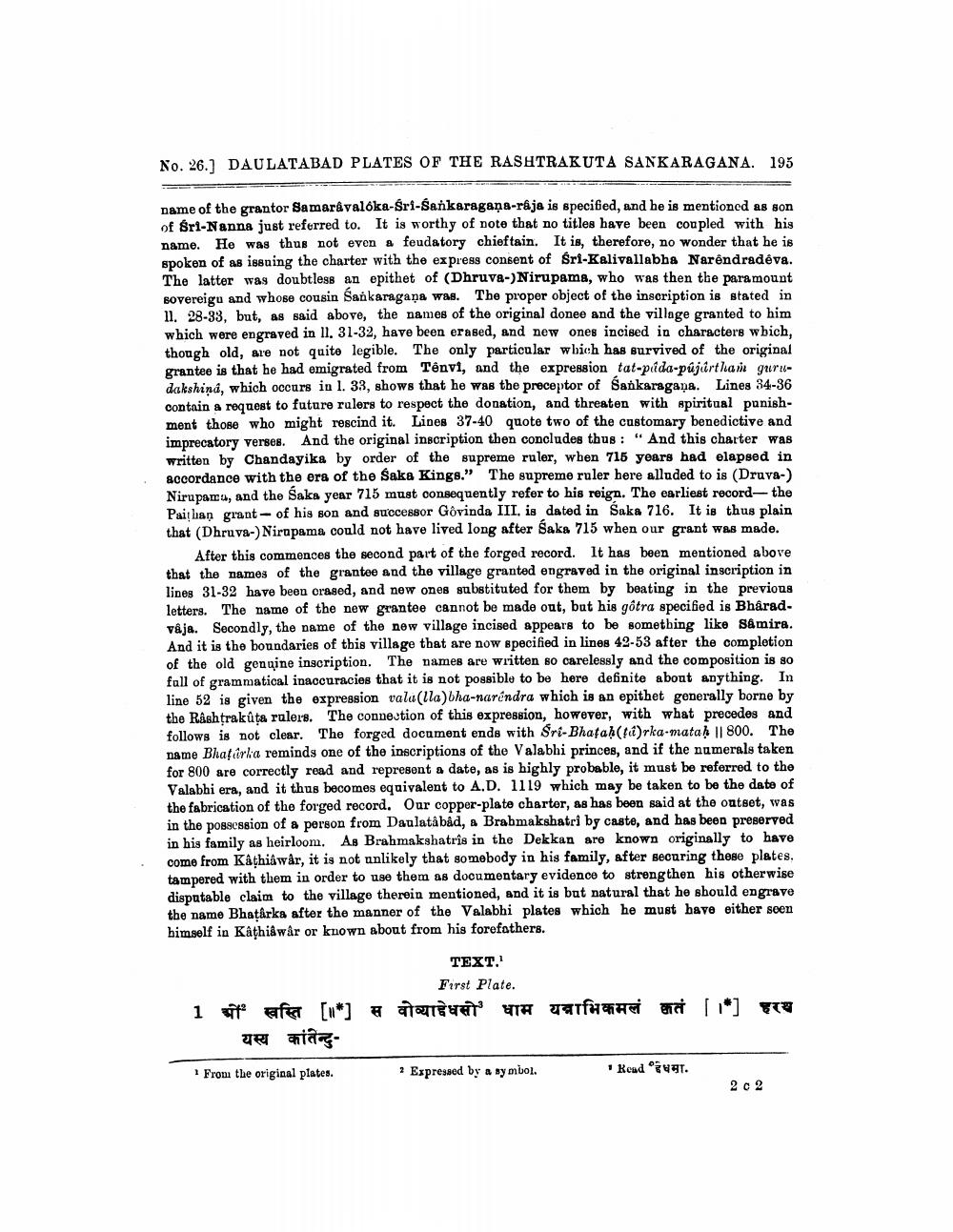________________
No. 26.1 DAULATABAD PLATES OF THE RASHTRAKUTA SANKARAGANA. 195
name of the grantor Samarávalóka-Śri-Sankaragaņa-raja is specified, and he is mentioned as son of Sri-Nanna just refurred to. It is worthy of note that no titles have been coupled with his name. He was thus not even a feudatory chieftain. It is, therefore, no wonder that he is spoken of as issuing the charter with the express consent of Sri-Kalivallabha Narendradeva. The latter was doubtless an epithet of (Dhruva-)Nirupama, who was then the paramount sovereigu and whose cousin Sankaragana was. The proper object of the inscription is stated in 11. 28-33, but, as said above, the names of the original donee and the village granted to him which were engraved in II. 31-32, have been erased, and new ones incised in characters which, though old, are not quite legible. The only particular which has survived of the original grantee is that he had emigrated from Tênvi, and the expression tat-paida-pujúrthai gurudakshind, which occurs in l. 33, shows that he was the preceptor of Sankaragana. Lines 34-36 contain a request to future rulers to respect the donation, and threaten with spiritual panishment those who might rescind it. Lines 37-40 quote two of the customary benedictive and imprecatory verses. And the original inscription then concludes thus : " And this charter was written by Chandayika by order of the supreme ruler, when 715 years had elapsed in accordance with the era of the Saka Kings.” The supreme ruler here alluded to is (Druva-) Nirupama, and the Saka year 715 must consequently refer to his reign. The earliest record the Paithan grant- of his son and successor Govinda III, is dated in Saka 716. It is thus plain that (Dhruva-) Nirupama could not have lived long after Saka 715 when our grant was made.
After this commences the second part of the forged record. It has been mentioned above that the names of the grantee and the village granted engraved in the original inscription in lines 31-32 have been craged, and new ones substituted for them by beating in the previous letters. The name of the new grantee cannot be made out, but his gôtra specified is Bharadvaja. Secondly, the name of the new village incised appears to be something like Samira. And it is the boundaries of this village that are now specified in lines 42-53 after the completion of the old gengine inscription. The names are written so carelessly and the composition is so fall of grammatical inaccuracies that it is not possible to be here definite about anything. In line 52 is given the expression valu(lla) bha-narendra which is an epithet generally borne by the Rashtrakůţa rulers. The connection of this expression, however, with what precedes and follows is not clear. The forged document ends with Sri-Bhatah(t)rka-matah || 800. The name Bhaterka reminds one of the inscriptions of the Valabhi princes, and if the numerals taken for 800 are correctly read and represent a date, as is highly probable, it must be referred to the Valabhi era, and it thus becomes equivalent to A.D. 1119 which may be taken to be the date of the fabrication of the forged record. Our copper-plate charter, as has been said at the outset, was in the possession of a person from Daulatåbåd, a Brahmakshatri by caste, and has been preserved in his family as heirloom. As Brahmakshatris in the Dekkan are known originally to have come from Kathiawår, it is not unlikely that somebody in his family, after securing these plates, tampered with them in order to use them as documentary evidence to strengthen his otherwise disputable claim to the village therein mentioned, and it is but natural that he should engrave the name Bhatarka after the manner of the Valabhi plates which he must have either seen himself in Kathiâwâr or known about from his forefathers.
TEXT.
First Plate. Tangu TH TaHRACIE 11*]
1 at afer [**] #
Jei atas
From the original plates.
* Expressed by a symbol.
Road 29.
2 c 2




